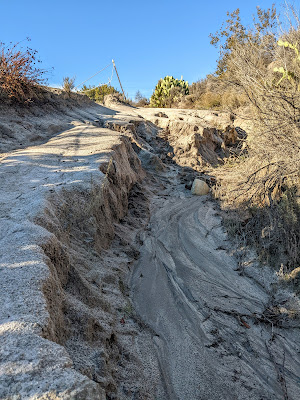The Man Who Could Move Clouds and Preservation
Borrego Trail, not to be confused with Borrego Canyon Trail, is a blacktop path that slices between a housing development and shrubby wilderness. Underneath it is a massive concrete box for water diversion, an effort to reduce the wash along the canyon. The box opens up and empties at the bottom of the trail, a gaping, angry throat.
It feels to me like the thing below belongs to another world, an unsettling idea. Not everyone is uncomfortable with the possibility of unknown things in close proximity. For Ingrid Rojas Contreras, the curtain between our world and others is threadbare and permeable.
In her memoir, The Man Who Could Move Clouds, Rojas Contreras recalls studying the works of Gabriel Garcia Marquez in school. She and her fellow Colombian students are puzzled by the lessons that visiting British and American teachers share. For these students, "magic realism was just realism."
*spoilers follow*
When Rojas Contreras' mother is nine she falls into a well and suffers a brain injury. The injury marks an awakening for her, grants her access to a myriad of worlds and lives. She can't remember her own physical life or family but, suddenly, is accepted by other places and beings. She can see the dead, predict who will soon be dead. She can communicate with animal spirits. She can read auras as clinically and accurately as notation.
Amnesia in Rojas Contreras' family correlates with acquiring the ability to live among the spirits. When she herself suffers a head injury in a bicycle accident in her 20s, her family watches with bated breath. Amnesia does not grant her access to the spirits, but it does wipe her clean. Her ability is the chance to learn her family anew, void of bias, full of wonder.
This is how she learns of her grandfather's gifts as a curendero, how she slowly recalls her mother's abilities and profession of fortune telling. This is also how she remembers the horrors of a childhood in the violence of Escobar era Colombia.
The book follows her re-learning her family, their magic, and the traumas, new and old, of their history. Her own magic is found in language, its power to produce image and memory, its softness and strength.
The story winds through the physical and magical history of her family. Uncles, aunts, cousins, distant Spaniards, all get their moments on the page. Much like Garcia Marquez's writing, their presence doesn't always make structural sense in the belly of the scene. But once the book is finished, it's clear that all the right people were invited to tell their piece. There's no story without community, no community without preservation of memory. Things change, people groups change, people die and leave or die and stay, and the stories rename the equilibrium.
I find the concrete box below Borrego Trail intimidating to think about, a hungry, fickle thing upon which I depend. The box is all that keeps the ridge of houses intact in high rains. My intimidation is, perhaps, misplaced. But it is an instinct, not a decision. It's a feeling that the thing sent to preserve us can swallow us whole, leave us and our world unrecognizable.
I borrowed this book from my library via Libby. It's read by Marisol Ramirez and is 10 hours and 58 minutes.




Comments
Post a Comment